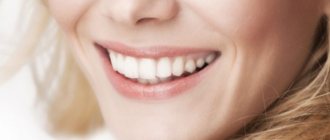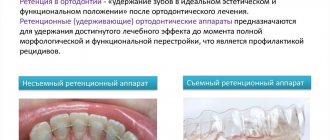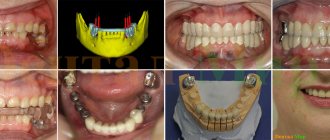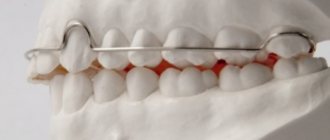The day of removing braces is a holiday for everyone who wore them. Therefore, first of all, I would like to congratulate you! But it’s too early to relax, because the treatment does not end there.
In the new position, the teeth are still unstable, and also, after wearing an orthodontic structure for a long time, some problems could arise. But don’t worry - we will give you a few simple recommendations, following which you will preserve the beauty of your smile for many years.
Is it possible to do without the retention stage?
For adult patients and adolescents who have had a permanent bite corrected, no. This is a mandatory stage in treatment. Although it is simpler than actively moving teeth, it is no less important. During the movement of teeth, the roots simply do not have time to get used to the new position. There is also muscle memory, and since the roots of the teeth, jaw bone, gums, ligaments are a living and constantly renewed system, then without reinforcement, a reverse movement can immediately begin - regression.
Example: treatment with braces took 2 years, after which the doctor did not install retainers or make mouth guards. The patient himself did not know that this needed to be done. The result was completely lost within 2 weeks.
This situation could have happened 15–20 years ago, when not all clinics worked according to the same standard. Nowadays, every orthodontist will manage the patient taking into account the fact that after treatment a retention stage is needed, regardless of whether aligners or braces were used.
Features of the retention period
Wearing non-removable retainers does not require any special operating conditions. You should exclude solid foods and the habit of gnawing anything from your diet. In the process of oral hygiene, toothbrushes with soft bristles, as well as dental floss and irrigator are used.
Removable retainers require more care. It is necessary to clean the product daily with a paste and brush, rinse it before use, store it in a container, and treat it in a special solution once a week.
The removable type of retainer should differ depending on the application on the upper or lower jaw, since the lower dentition is more difficult to correct, and therefore the likelihood of the teeth returning to their previous position is higher. If the products are damaged, they must be replaced.
Immediately after the braces are removed, pain may occur. This is explained by the fact that the teeth have been subjected to stress for a long time and after eliminating the impact on them, the jaw muscles relax. Orthodontists also explain tooth pain by the process of returning teeth to their original place. Once the retainers are installed, the pain should disappear. Although the orthodontic retainers themselves do not exert any noticeable pressure.
How does the retention stage proceed?
There are two types of retainers:
- Transparent removable aligners, which are made from dental impressions after treatment.
They are well known to those who wore aligners during active tooth movement. In this case, retainers are the last pair of aligners. Those who have had braces receive these clear aligners for the first time. They are made immediately after the braces are removed. Mouthguards cover all teeth - from the front incisors to the “sevens” or “eights”.
Removable mouth guard
- Fixed retainers.
This is a metal wire that looks like a braces arch, only it is shorter. It is glued to the back of the teeth using a material similar to filling. The retainer is not placed on all teeth, but only on the 6–8 front ones. The arc and the place where it joins are smooth, they do not interfere with diction, are invisible externally, do not affect nutrition and, in general, are not felt in any way.
Fixed retainer
Dental care after braces
Immediately after the braces are removed, your teeth may not look quite perfect.
This is explained by the fact that after prolonged exposure to the structure, the enamel is damaged, at least slightly, and plaque may accumulate and even signs of caries may appear. To eliminate the consequences of wearing orthodontic appliances and prepare teeth for further treatment, it is recommended to resort to professional teeth cleaning. But this should be done no earlier than a week after the doctor removes the braces to allow the tooth enamel to recover. If caries is detected, the disease is treated before cleaning or starting to wear retainers. Then fluoridation of teeth is performed to strengthen the enamel.
Oral hygiene in the absence of a permanent structure does not differ from classical daily tooth brushing. Movements should be vertical, sweeping or circular. Hygiene procedures should be supplemented with rinses, irrigators and dental floss. If retainers are installed, the dental care procedure may have some peculiarities.
How long does this stage last?
Standard – twice as long as the treatment lasted. That is, with treatment for a period of 1 year, the retention stage lasts at least two years. But often, even after this period, it is too early to completely part with the aligners: many patients noted that the teeth may still begin to move. There is a risk of partially or even completely losing the result that was achieved over the whole year.
You can independently determine how great the risk of regression is: do not wear retainers for 1-2 days, and then put them on and listen to your feelings. The aligners were put on with little effort, is there a feeling of pressure on the teeth, especially on those whose position before treatment was more deviated from the norm? This means that microscopic movements of the teeth have already occurred in 1–2 days. It is too early to interrupt the retention stage.
When interrupting the retention stage, it is important not to rush
Duration of wearing a retention device
The retention device is worn:
- constantly, during the first 3-4 months, except in cases where the retainer can be removed when eating;
- continue on a non-permanent basis for at least 12 months. to ensure sufficient time for the reconstruction of gingival tissues;
- in growing patients - continue on an intermittent basis until growth is complete.
The retention device is installed on the day the braces are removed. Its type and model are determined by the orthodontist.
In order to find out about the prices for installing a retention device, take a look at the prices section.
How to consolidate the result?
The practice of orthodontists shows that relapses are most often caused by the early removal of retainers or their inconsistent wearing. If you follow all the recommendations of the orthodontist and attend routine examinations in a timely manner, the results of treatment will last for many years and your smile will remain irresistible.
When treating complex anomalies, the doctor may recommend additional observation by an orthopedist, since posture affects the bite and can “pull” it back to an incorrect position, but this is still not an ordinary case.
Guarantees
Preservation of the result can be ensured only if the regime of wearing retention devices is observed, as well as other conditions specified above. Otherwise, there may be curvature of the teeth, deterioration of the bite and functions of the dental system, the aesthetics of the smile, for which the Contractor is not responsible and which are subject to re-treatment at the current price list. The warranty period for retainers is 12 months from the date of their installation. This means that during this period, retainers are repaired free of charge if they break, unless it is the patient’s fault. If the patient is at fault, or after the specified warranty period has expired, the repair (replacement) of retention devices is carried out according to the currently valid price list. The service life of fixed retainers is 5-7 years, removable retainers are 1 year, removable plates are 3-5 years.
What if you have to wear it always?
The option that the orthodontist will advise not to give up retainers altogether is possible. This usually happens in adult patients - it is not always possible to completely correct the posture and position of the joints with braces or aligners alone, so the tendency to regression in the state of occlusion (that is, to move again to the wrong position) may persist.
Even after 3–4 years of the retention stage, regression is possible! Especially in adults.
But this situation is worth looking at from the other side. In dentistry, there are not many types of treatment that give results once and for all.
- Even well-installed fillings sometimes need to be changed. Some people last 20 years, but on average 10 years of service is normal. The same applies to bridges and individual crowns.
- Whitening – the result lasts up to 1 year (if you follow the doctor’s recommendations).
- Professional cleaning requires repetition every 6 months, even if you brush your teeth very carefully at home.
- Veneers, like fillings, last on average 10-12 years, and also tend to fall off.
- Conventionally, implants can be classified as “eternal” types of treatment in dentistry, but there are exceptions - the crowns of implants are also sometimes changed.
And an orthodontist deals not with prostheses or implants, but with living tissue. It is quite natural that if the roots of the teeth have already shifted once due to the peculiarities of their structure, incorrect posture or bad habits, this can happen again.
Moreover, if the patient corrected the bite at 35–40 years old. It turns out that he lived with an incorrect permanent bite for about 25 years, so it is quite expected that after 1-2 years of treatment and the retention stage, the roots will not get used to the new position and will tend to the old place!
This is not an argument against treatment, and all the benefits remain with the patient: a smooth, beautiful smile, easier dental care and maintenance of their health, opportunities for prosthetics or installation of veneers. This only means that the retention stage will probably last indefinitely.
Is it possible to wear a mouthguard constantly at night? Of course, yes - it does not interfere with sleep and does not cause any inconvenience. It needs to be updated once a year or even less often, since the shape of the dentition is already unchanged. And a non-removable retainer does not need to be updated at all, except in cases of partial correction.
If you follow the doctor's recommendations, the achieved result is preserved forever. These recommendations are not at all complicated: patients get used to them and do not notice any restrictions in their lives, but their contribution to dental health is very significant.
Other articles:
Is it possible to correct an overbite at an older age?
How to make your smile perfect? Treatment plus aesthetics
Types of orthodontic systems: from plates to aligners
Fixed retainers
Material for making a permanent retainer
A non-removable retainer is designed to be worn continuously during the retention period.
The product has the shape of an arc, permanently fixed with special glue on the inside of the teeth.
The material from which the retainer is made can vary:
- metal (medical steel);
- fiber system (polyamide, polyethylene, carbon fiber, fiberglass).
The process of preparing and installing a permanent retainer
A permanent retainer is installed almost immediately after the braces are removed.
There are a number of mandatory procedures that precede the installation of a retainer:
- careful examination of the patient’s oral cavity;
- treatment of carious teeth and gum inflammation (if necessary);
- professional hygienic cleaning;
- preparation of enamel using special preparations that allow you to securely attach a permanent retainer to dental crowns.
After completing these procedures, the orthodontist begins fixing the retainer in the patient’s mouth. This process consists of the following steps:
- Dental crowns are treated with a substance that increases the reliability of their adhesion to the composite material.
- The use of a permanent fiber retainer requires the preparation of crowns in a special way. On their inner side it is necessary to form grooves for laying the tape.
- The treated surface is thoroughly dried.
- The retainer is fixed with glue;
- The retainer attachment points are polished to ensure that the device is comfortable in the patient’s mouth.
When an indirect fixation method is provided, the orthodontist first makes an impression of the jaw. A retainer is attached to the manufactured jaw model and transferred to the patient’s teeth using a special silicone key.
Duration of wearing a fixed retainer
The time for using a retainer, as well as its type, is determined by the doctor and depends on the patient’s age and the complexity of the pathology.
Usually the retention period exceeds the active one by 1.5 - 2 times; there are cases when wearing a retainer is prescribed for life.
Factors that influence the duration of the consolidation stage:
- condition of the patient’s dentition (presence or absence of adentia);
- speed of displacement of dental units;
- condition of periodontal tissues.
Hygienic care
Since during the period of wearing braces patients get used to the peculiarities of oral hygiene procedures, nothing new awaits them. Still needed:
- use the paste carefully and not with a stiff brush;
- After each meal, rinse your mouth with warm water;
- use an irrigator, brush, dental floss;
- Have your teeth professionally cleaned once every six months.
Advantages and disadvantages of permanent retainers
The advantages of permanent retainers include:
- high aesthetics of the product;
- fastening speed;
- high efficiency;
- there is practically no adaptation period;
- the impact on teeth occurs 24 hours a day.
The disadvantages of permanent retainers are:
- the need for regular visits to the dental office;
- there is a possibility that a small part of the retainer will come off (the doctor must immediately fix the problem);
- High-quality daily care is important, the absence of which can lead to the formation of tartar and gum disease of the patient.
A correctly selected retention device and compliance with all the instructions of the treating orthodontist will ensure that your new smile remains flawless, even and highly aesthetic.











